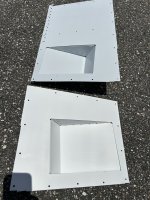Freemasm
Well Known Member
I’ve had the baked version professionally applied to FAs before. Amazing finish and tough as nails
Disclaimer = I suck at painting. I suck at painting. I suck at painting.
I’m trying the cold process on some cockpit interior pieces to see if it might be the way to go.
Expensive coatingbut:
Limited surface prep. No etch. No conversion coat
No primer required
No thinning
VERY high solids
I sprayed two floor panels with Brilliant White and Hidden White. Coating/liquid is surprisingly thin for such heavy solids. Only surface prep was a scuff with scotchbrite (suitable per their tech support when a blast profile isn’t do-able) and a solvent wipe. Both were shot with a cheap, POS HVLP gun. The coating lays down very smooth and seems to be equally forgiving. Fast drying, but relatively slow full cure. Within two hours, I was seriously flexing the panels.
My worse-than-amateur self got a pretty dang good finish. The time/money saved by getting to omit a lot of prep work common to most paint apps will more than easily offset the high cost. So, if you prefer something else/never heard of it/your Dad never used it/painted your interior with something else/, great. This is a review, not a debate. Another option for people looking for such.
BTW, is the whiter of the two too much for (the majority of) a cockpit? These are before final coat. Canopy bow and panel will both be an appropriate gray.
Disclaimer = I suck at painting. I suck at painting. I suck at painting.
I’m trying the cold process on some cockpit interior pieces to see if it might be the way to go.
Expensive coatingbut:
Limited surface prep. No etch. No conversion coat
No primer required
No thinning
VERY high solids
I sprayed two floor panels with Brilliant White and Hidden White. Coating/liquid is surprisingly thin for such heavy solids. Only surface prep was a scuff with scotchbrite (suitable per their tech support when a blast profile isn’t do-able) and a solvent wipe. Both were shot with a cheap, POS HVLP gun. The coating lays down very smooth and seems to be equally forgiving. Fast drying, but relatively slow full cure. Within two hours, I was seriously flexing the panels.
My worse-than-amateur self got a pretty dang good finish. The time/money saved by getting to omit a lot of prep work common to most paint apps will more than easily offset the high cost. So, if you prefer something else/never heard of it/your Dad never used it/painted your interior with something else/, great. This is a review, not a debate. Another option for people looking for such.
BTW, is the whiter of the two too much for (the majority of) a cockpit? These are before final coat. Canopy bow and panel will both be an appropriate gray.


